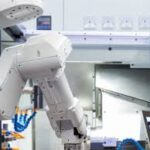Light, yet incredibly strong, and streamlined-looking carbon fiber is no longer the exclusive preserve of supercars and high-end devices. It’s the material of choice now in applications that require top-notch performance, minimum weight, and ruggedness. Raw carbon fiber sheets, however, are not exactly a joy to work with. That’s, until CNC carbon fiber machining steps into the picture, taking this high-tech material and converting it into intricate, functional parts with uncompromising accuracy.
Today, we will discuss the main industries that are greatly dependent on carbon fiber parts machined by CNC and why they’re opting for custom carbon fiber instead of standard metal or plastic parts.
1. Aerospace & Aviation
Weight reduction in aerospace is like saving fuel and making it efficient. CNC machining of carbon fiber enables businesses to produce parts that are light but extremely tough and are capable of enduring harsh environments.
- Common Applications: drone frameworks, structural panels, brackets, and internal components.
- Advantages: corrosion-proofing, vibration dampening, and weight reduction.
Special carbon fiber components are perfectly suited for aircraft since they offer the required strength at minimum overall weight, so that flight range and efficiency can be maximized.
2. Motorsport & Automobile
Speed and safety in the motorsport and automobile manufacturing world. That’s why carbon fiber has become a go-to material for both bodywork and functional parts. CNC machining makes every component fit perfectly and withstand pressure.
- Common Applications: spoilers, splitters, interior trim, dashboards, steering wheels.
- Advantages: high stiffness, light weight, good heat resistance.
Whether for a racing car to cut seconds off lap times or an exotic car that requires trendy looks, custom carbon fiber parts provide the best of both function and form.
3. Medical Devices
Medical parts must be lightweight, biocompatible, and have even structures. CNC-machined carbon fiber parts are being used more often in surgical equipment, prosthetics, and diagnostic devices.
- Common Applications: orthotic braces, imaging parts, braces, prosthetic limbs.
- Advantages: radiolucency (will not interfere with imaging), high strength, comfort.
CNC-machined carbon fiber can be used to create precisely manufactured, ergonomically shaped components, enhancing patient experience and maintaining device integrity and hygiene.
4. Consumer Electronics
As devices get thinner, lighter, and more powerful, manufacturers are using carbon fiber for both its technical properties and visual appeal. CNC machining provides the level of fine detail required in compact electronics.
- Common Applications: laptop lids, drone bodies, phone cases, gaming accessories.
- Advantages: thin look, electromagnetic shielding, heat resistance.
With CNC machining of carbon fiber, manufacturers create durable, high-performance components that satisfy performance as well as aesthetic requirements in consumer electronics.
Conclusion
From industry to industry, it’s well understood: CNC carbon fiber machining is transforming the production landscape of today. From unmatched strength-to-weight ratio to design versatility, this process allows firms to create new possibilities and deliver improved results, all from applications in aerospace, robotics, medical, and much more. If you are looking for custom carbon fiber parts, then you can consider working with FastPreci for the best high-quality parts.

